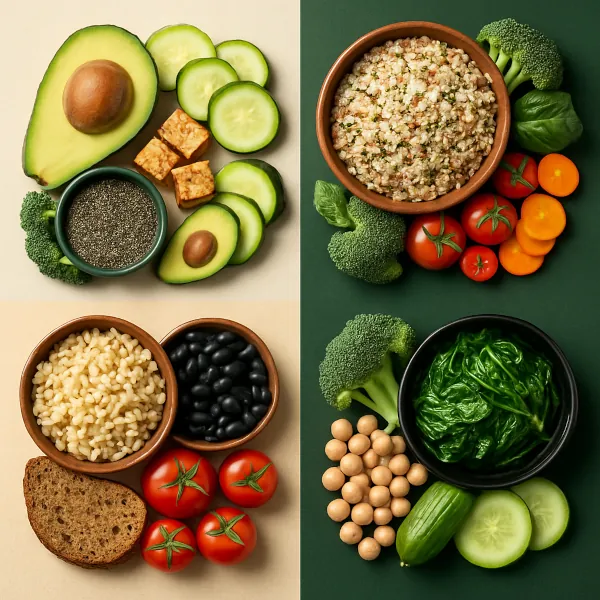Compare the top vegan diets — keto, low-carb, traditional, and whole-food plant-based — with practical tips, sample meals, and personalized guidance for your health goals.
What Is a Keto Vegan Diet Comparison and Why Does It Matter?
A keto vegan diet comparison is a must for anyone looking to follow a plant-based lifestyle while also focusing on specific goals like weight loss, improved energy, or chronic disease prevention. Not all vegan diets are the same — they differ significantly in how they impact metabolism, digestion, and overall health.
Understanding the differences helps you make smarter food choices and find a vegan approach that actually works for your lifestyle.
🧠 Did you know? According to the Academy of Nutrition and Dietetics, well-planned vegetarian and vegan diets are healthful, nutritionally adequate, and may help prevent and treat certain diseases.
Key Differences: How Are These Diets Actually Different?
Macronutrient Breakdown: The Big Picture
Each approach varies based on the proportions of carbs, protein, and fats — your macronutrients.
| Diet | Carbs | Protein | Fats |
|---|---|---|---|
| Keto Vegan | 5–10% | 20–25% | 70–80% |
| Traditional Vegan | 60–75% | 15–20% | 10–20% |
| Low-Carb Vegan | 20–30% | 20–25% | 40–50% |
| Whole-Food Plant-Based | 60–70% | 15–20% | 10–20% |
🍠 Fun fact: Sweet potatoes — a staple in many traditional vegan diets — are high in carbs, but also packed with fiber and beta-carotene.
The keto vegan diet is all about nutritional ketosis — a metabolic state where your body uses ketones from fat as its primary energy source. This requires keeping carb intake very low, which can be tricky with a plant-based diet that’s usually carb-heavy.
The traditional vegan diet leans on grains, legumes, and fruits — great for energy, but it can spike blood sugar if not balanced properly.
The plant-based whole food diet focuses on food quality: no or very few processed foods, even if they’re carb-rich, as long as they’re complex and nutrient-dense.
The low-carb vegan diet finds a middle ground — fewer refined carbs without going full keto.
Health Benefits: What Can Each Diet Offer?
1. Keto Vegan
- Can support rapid fat loss, especially early on.
- Helps regulate blood sugar and may be useful for insulin resistance or metabolic syndrome.
- Promotes greater satiety with fewer calories.
- Can lower triglycerides and raise HDL (“good” cholesterol).
📚 Research suggests that ketogenic diets can significantly improve insulin sensitivity and reduce chronic inflammation. Source: Frontiers in Nutrition, 2021
2. Whole-Food Plant-Based
- Supports heart health, reduces risk of Type 2 diabetes, and lowers cancer risk.
- Promotes gut health and may improve longevity.
- Packed with fiber, antioxidants, and anti-inflammatory compounds.
🩺 A Harvard-backed study published in the Journal of the American College of Cardiology found that plant-based whole-food diets cut heart disease risk by up to 25%. Source: JACC, 2017
3. Traditional Vegan
- Ideal for beginners due to its flexibility.
- Budget-friendly with basic grocery items.
- Can include too many processed carbs and oils if not monitored.
4. Low-Carb Vegan
- Offers stable energy levels throughout the day.
- Can help reduce fat mass and curb cravings.
- Easier to stick with than full keto due to greater food variety.
🔬 According to Harvard Health Publishing, plant-rich low-carb diets improve blood sugar levels and lipid profiles. Source: Harvard Health
Challenges and Nutritional Watch-Outs
No matter which vegan path you choose, there are key nutrients to keep an eye on:
- Vitamin B12: Not found in plant foods — supplement is essential.
- Omega-3s (EPA/DHA): Found in algae-based supplements; flax and chia provide ALA, but the conversion is inefficient.
- Iron and zinc: Found in legumes, seeds, and fermented foods — pairing with vitamin C helps absorption.
📌 Pro tip: Pair high-iron foods (like lentils) with citrus fruits or bell peppers to boost iron absorption.
Unique Challenges by Diet
| Diet | Main Challenges |
|---|---|
| Keto Vegan | Harder to reach ketosis, limited food variety, higher grocery cost |
| Plant-Based | Planning enough complete proteins from whole foods |
| Traditional | Overreliance on processed foods, nutrient deficiencies |
| Low-Carb | Limited fruit/legume variety, harder to get fiber |
🍄 Fun fact: Mushrooms and seaweed are rich in umami — a flavor that can make strict diets like keto vegan feel more satisfying.
Sample Day of Eating for Each Diet
🥑 Keto Vegan
- Breakfast: Green smoothie with avocado, spinach, coconut milk, chia seeds, and pea protein
- Lunch: Cauliflower rice bowl with grilled tofu, zucchini, basil pesto, and olive oil
- Dinner: Creamy mushroom soup made with cashew cream
🌾 Whole-Food Plant-Based
- Breakfast: Oatmeal with banana, ground flaxseed, cinnamon, and almond milk
- Lunch: Quinoa, lentils, steamed broccoli, carrots, and tahini drizzle
- Dinner: Veggie stew with brown rice and grilled tempeh
🧄 Traditional Vegan
- Breakfast: Whole wheat toast with hummus and herbal tea
- Lunch: Rice, black beans, sautéed potatoes, and simple salad
- Dinner: Vegan lasagna with tomato sauce and soy protein
🥦 Low-Carb Vegan
- Breakfast: Unsweetened vegan yogurt with almonds, coconut, and berries
- Lunch: Arugula salad with roasted zucchini, chickpeas, and olive oil
- Dinner: Sautéed spinach with mushrooms, onions, and pumpkin seeds
Pros & Cons at a Glance
| Diet | Pros | Cons |
|---|---|---|
| Keto Vegan | Fast weight loss, steady energy, blood sugar control | Hard to follow, expensive, restrictive |
| Plant-Based | Long-term health, nutrient-dense, gut-friendly | Requires more prep and variety |
| Traditional | Easy to start, cost-effective | Can rely too much on junk food |
| Low-Carb | Balance of flexibility and weight management | Less fruit and whole grains than other approaches |
Who Should Try Which Diet?
| Goal or Lifestyle | Best Fit |
|---|---|
| Want to lose weight fast | Keto Vegan |
| Dealing with prediabetes or diabetes | Keto or Low-Carb Vegan |
| Busy or beginner | Traditional Vegan |
| Focus on long-term health | Whole-Food Plant-Based |
| Athletic or active lifestyle | Plant-Based or Low-Carb Vegan |
| Managing high cholesterol | Plant-Based Whole Food |
| Love trying new recipes | Keto Vegan or Whole-Food |
🏋️♂️ Athlete tip: Creatine isn’t found in plant foods but is widely used in sports performance. Vegan creatine supplements can help with strength and recovery.
FAQ: Common Questions About Vegan Diets
❓ Can you build muscle on a vegan keto diet?
Yes — as long as you consume enough plant protein (tofu, tempeh, seitan) and supplement with nutrients like B12 and omega-3s.
❓ Is it safe to do keto and be vegan at the same time?
It’s safe with good planning. Focus on nutrient-dense fats, low-carb veggies, and be mindful of deficiencies.
❓ Can I switch between diets over time?
Absolutely. Many people shift between low-carb and whole-food plant-based depending on their goals.
How to Start Today
- Pick your diet type based on your health and lifestyle.
- Plan 3 go-to meals you can repeat for the week.
- Grocery shop with intention — make a list!
- Supplement smartly: B12 is a must; consider omega-3 and iron too.
- Track your macros with apps like Cronometer or MyFitnessPal.
- Try out new recipes that match your chosen path.
Make It Work for Your Daily Life
- Keep plant-based pantry staples on hand: tofu, canned beans, nuts, and frozen veggies.
- Batch cook and freeze meals for the week.
- Make your meals visually appealing and colorful.
- Avoid crash dieting — get support from a dietitian if you’re managing a condition.
📢 Ready to Choose Your Best Vegan Diet?
✨ Feel like one of these vegan diets is calling your name? Bookmark this guide, share it with a friend, and start your journey today!
💬 Drop a comment: which vegan approach have you tried — or are most curious about?

